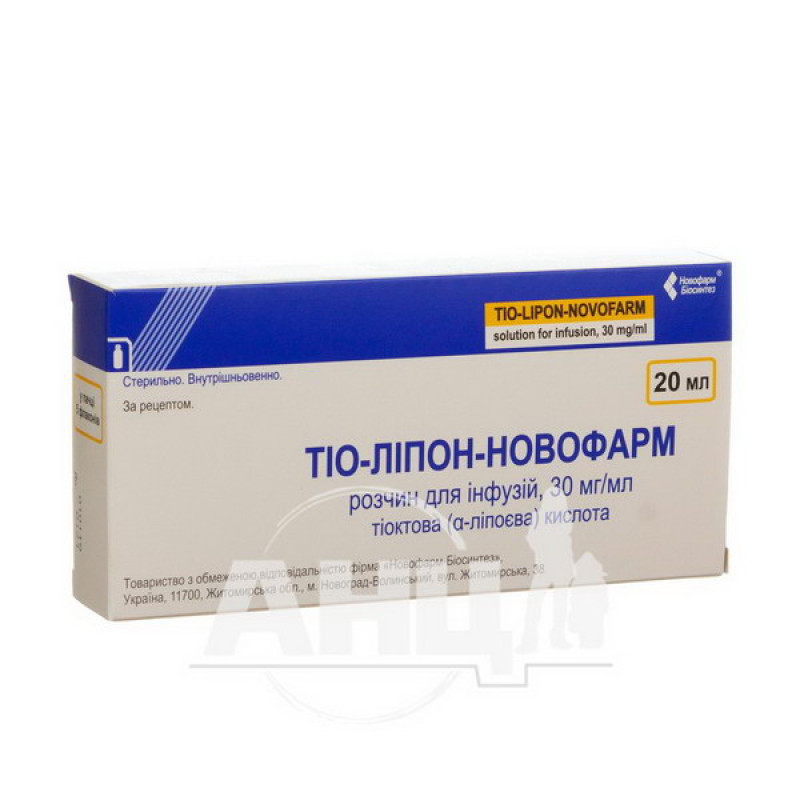Tio-Lipon-Novopharm solution for infusion 30 mg/ml bottle 20 ml No. 5

Thio-lipon-Novopharm infusion solution is used for the following indications: paresthesia in diabetic polyneuropathy.
Composition
The active substance is thioctic (a-lipoic) acid (1 ml of solution contains thioctic (a-lipoic) acid 30 mg).
Excipients: meglumine, macrogol 300, water for injections.
Contraindication
hypersensitivity to thioctic (α-lipoic) acid or other components of the drug; heart and respiratory failure; acute phase of myocardial infarction; acute cerebrovascular accident; chronic alcoholism and other conditions that can lead to lactic acidosis.Method of application
The drug should be administered as an intravenous drip infusion at a dose of 600 mg per day.
For this purpose, 20 ml (corresponding to 600 mg of thioctic (α-lipoic) acid) should be diluted in 50-250 ml of 0.9% sodium chloride solution. The administration should be carried out slowly - the duration of the infusion should be at least 30 minutes.
The solution prepared for infusion should be used immediately, using light-protective black bags.
At the beginning of the course of treatment, the drug should be administered intravenously for 1-2 weeks. In the future, you can switch to maintenance therapy with oral dosage forms of thioctic (a-lipoic) acid at a dose of 600 mg per day.
Application features
Pregnant women
There is insufficient experience with the use of the drug during pregnancy and breastfeeding, so it should not be prescribed during these periods.
Children
The efficacy and safety of the drug in children have not been established, therefore it should not be prescribed to this age group of patients.
Drivers
When prescribing the drug, caution should be exercised when driving vehicles and engaging in other potentially dangerous activities that require increased concentration and quick reactions.
Overdose
Symptoms: nausea, vomiting and headache. When using very high doses of 10 to 40 g of thioctic (a-lipoic) acid in combination with alcohol, severe intoxication is observed, which can be fatal. The clinical picture of poisoning is initially manifested by psychomotor agitation or impaired consciousness and subsequently progresses to attacks of generalized convulsions and the development of lactic acidosis. The consequences of intoxication may be hypoglycemia, shock, rhabdomyolysis, hemolysis, acute skeletal muscle necrosis, DIC, bone marrow suppression and multiorgan failure.
Treatment. If significant intoxication is suspected (> 80 mg/kg body weight of thioctic (a-lipoic) acid), immediate hospitalization and implementation of generally accepted measures (e.g., artificial vomiting, gastric lavage, administration of activated charcoal) are indicated. Treatment of generalized convulsive attacks, lactic acidosis and other consequences of intoxication that threaten the patient's life should be guided by modern principles of intensive care and symptomatic. To date, there is no data on the feasibility of using hemodialysis, hemoperfusion or hemofiltration methods within the framework of forced removal of thioctic (a-lipoic) acid.
Side effects
From the side of the central nervous system: in some cases, change or disturbance of taste sensations, headache, hot flashes, increased sweating, difficulty breathing, increased intracranial pressure, dizziness, convulsions, visual disturbances and double vision. In most cases, all these manifestations resolve on their own.
Gastrointestinal tract: in some cases, with rapid administration of the drug, nausea, vomiting, diarrhea, abdominal pain were observed, which resolved on their own.
On the part of the blood: in some cases, petechial hemorrhages in the mucous membranes/skin, platelet dysfunction, hypocoagulation, hemorrhagic rashes (purpura), thrombophlebitis.
Metabolic disorders: as a result of improved glucose absorption, in some cases blood sugar levels may decrease, which may cause symptoms similar to hypoglycemia, such as dizziness, increased sweating, headache, and visual disturbances.
On the part of the immune system: in rare cases, skin rash, urticaria, itching, eczema, as well as systemic reactions up to the development of anaphylactic shock, insulin autoimmune syndrome.
From the side of the cardiovascular system: with rapid administration, pain in the heart area and tachycardia may occur, which resolve on their own.
Interaction
Thioctic (a-lipoic) acid solution is incompatible with glucose solution, Ringer's solution and with solutions that can react with SH-groups or disulfide bonds.
Storage conditions
Store in the original packaging at a temperature not exceeding 25 °C, out of the reach of children.
Due to the fact that thioctic (a-lipoic) acid is sensitive to light, the vials should be stored in a cardboard box until their immediate use.
Shelf life - 2 years.
There are no reviews for this product.
There are no reviews for this product, be the first to leave your review.
No questions about this product, be the first and ask your question.







